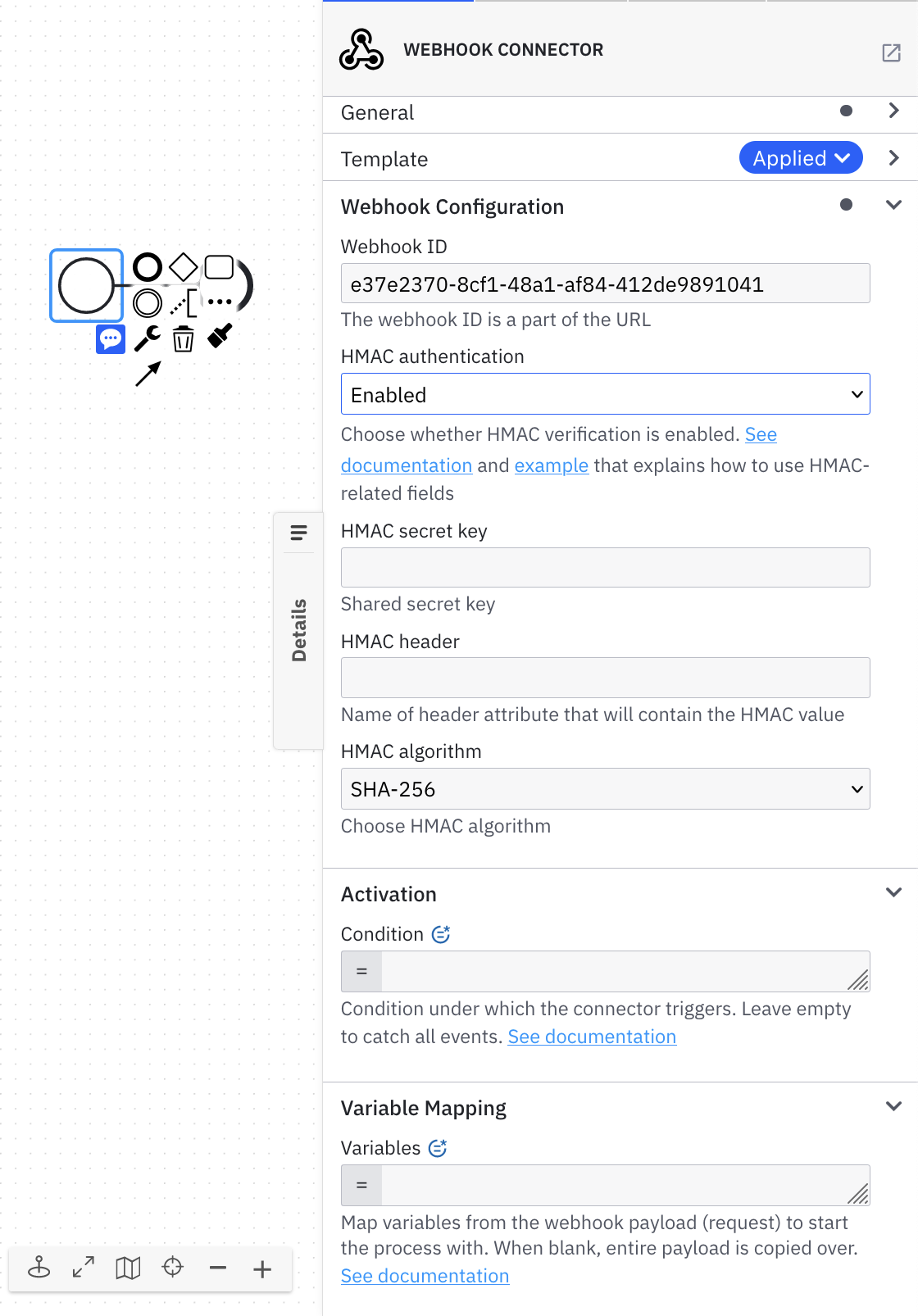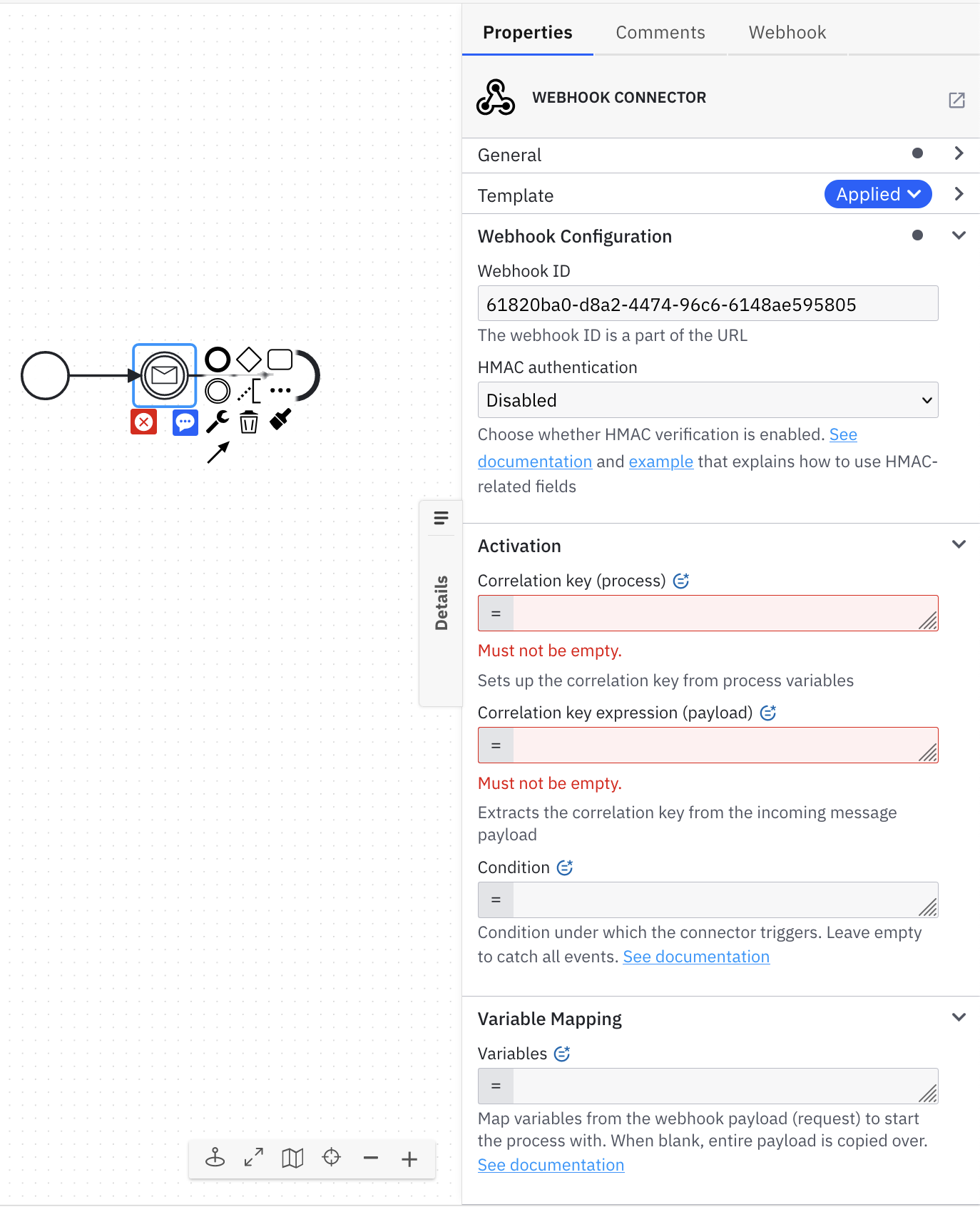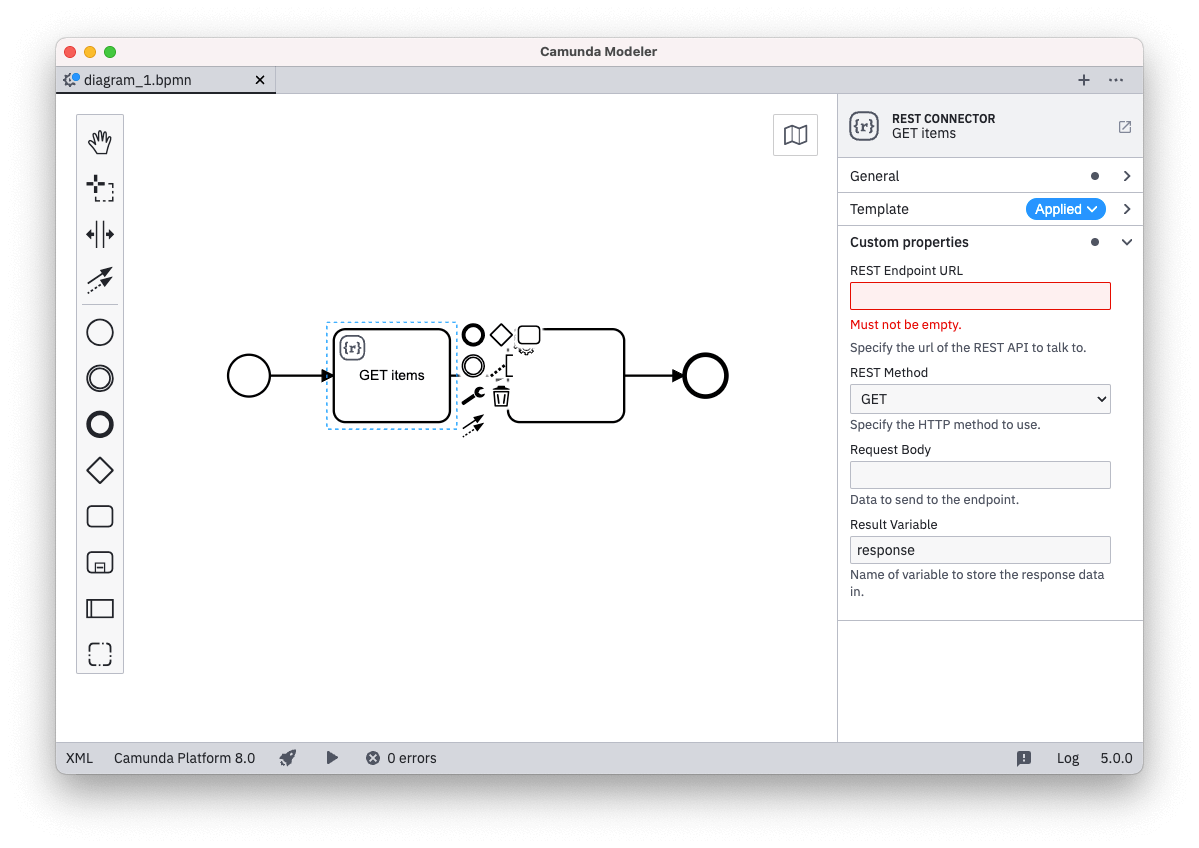Connector templates
Connector templates are JSON configuration files, which customize how a BPMN element is shown, and how it can be configured by process developers. Connector templates are a specific kind of element templates.
Before developing one, you'll need to decide what you would like to achieve with your Connector.
Currently, the options are:
- Starting a BPMN process, triggered by external service - use inbound start event Connector template
- Continue process with an intermediate catch event emitted by external service call - use inbound intermediate catch event Connector templates
- Trigger an external service - use outbound Connector template
Do not confuse Connector templates with the Connector template, which is used to supply boilerplate code and configuration when developing a new custom Connector.
Inbound start event Connector templates
You can, for example, allow the user to model and configure the following HTTP Webhook Connector by providing a simple JSON configuration:
- Process modeling view
- Connector template configuration

{
"$schema": "https://unpkg.com/@camunda/zeebe-element-templates-json-schema/resources/schema.json",
"name": "Webhook Connector",
"id": "io.camunda.connectors.webhook.WebhookConnector.v1",
"version": 1,
"description": "Configure webhook to receive callbacks",
"documentationRef": "https://docs.camunda.io/docs/components/connectors/out-of-the-box-connectors/http-webhook/",
"category": {
"id": "connectors",
"name": "Connectors"
},
"appliesTo": ["bpmn:StartEvent"],
"elementType": {
"value": "bpmn:StartEvent"
},
"groups": [
{
"id": "endpoint",
"label": "Webhook Configuration"
},
{
"id": "activation",
"label": "Activation"
},
{
"id": "variable-mapping",
"label": "Variable Mapping"
}
],
"properties": [
{
"type": "Hidden",
"value": "io.camunda:webhook:1",
"binding": {
"type": "zeebe:property",
"name": "inbound.type"
}
},
{
"type": "Hidden",
"value": "ConfigurableInboundWebhook",
"binding": {
"type": "zeebe:property",
"name": "inbound.subtype"
}
},
{
"label": "Webhook ID",
"type": "String",
"group": "endpoint",
"binding": {
"type": "zeebe:property",
"name": "inbound.context"
},
"description": "The webhook ID is a part of the URL"
},
{
"id": "shouldValidateHmac",
"label": "HMAC authentication",
"group": "endpoint",
"description": "Choose whether HMAC verification is enabled. <a href='https://docs.camunda.io/docs/components/connectors/out-of-the-box-connectors/http-webhook/#make-your-http-webhook-connector-for-receiving-messages-executable' target='_blank'>See documentation</a> and <a href='https://docs.camunda.io/docs/components/connectors/out-of-the-box-connectors/http-webhook/#example' target='_blank'>example</a> that explains how to use HMAC-related fields",
"value": "disabled",
"type": "Dropdown",
"choices": [
{
"name": "Enabled",
"value": "enabled"
},
{
"name": "Disabled",
"value": "disabled"
}
],
"binding": {
"type": "zeebe:property",
"name": "inbound.shouldValidateHmac"
}
},
{
"label": "HMAC secret key",
"description": "Shared secret key",
"type": "String",
"group": "endpoint",
"optional": true,
"binding": {
"type": "zeebe:property",
"name": "inbound.hmacSecret"
},
"condition": {
"property": "shouldValidateHmac",
"equals": "enabled"
}
},
{
"label": "HMAC header",
"description": "Name of header attribute that will contain the HMAC value",
"type": "String",
"group": "endpoint",
"optional": true,
"binding": {
"type": "zeebe:property",
"name": "inbound.hmacHeader"
},
"condition": {
"property": "shouldValidateHmac",
"equals": "enabled"
}
},
{
"label": "HMAC algorithm",
"group": "endpoint",
"description": "Choose HMAC algorithm",
"value": "sha_256",
"type": "Dropdown",
"choices": [
{
"name": "SHA-1",
"value": "sha_1"
},
{
"name": "SHA-256",
"value": "sha_256"
},
{
"name": "SHA-512",
"value": "sha_512"
}
],
"binding": {
"type": "zeebe:property",
"name": "inbound.hmacAlgorithm"
},
"condition": {
"property": "shouldValidateHmac",
"equals": "enabled"
}
},
{
"label": "Condition",
"type": "String",
"group": "activation",
"feel": "required",
"optional": true,
"binding": {
"type": "zeebe:property",
"name": "inbound.activationCondition"
},
"description": "Condition under which the connector triggers. Leave empty to catch all events. <a href='https://docs.camunda.io/docs/components/connectors/out-of-the-box-connectors/http-webhook/#make-your-http-webhook-connector-for-receiving-messages-executable' target='_blank'>See documentation</a>"
},
{
"label": "Variables",
"type": "String",
"group": "variable-mapping",
"feel": "required",
"binding": {
"type": "zeebe:property",
"name": "inbound.variableMapping"
},
"description": "Map variables from the webhook payload (request) to start the process with. When blank, entire payload is copied over. <a href='https://docs.camunda.io/docs/components/connectors/out-of-the-box-connectors/http-webhook/#make-your-http-webhook-connector-for-receiving-messages-executable' target='_blank'>See documentation</a>"
}
],
"icon": {
"contents": "data:image/svg+xml,%3Csvg id='icon' xmlns='http://www.w3.org/2000/svg' width='18' height='18' viewBox='0 0 32 32'%3E%3Cdefs%3E%3Cstyle%3E .cls-1 %7B fill: none; %7D %3C/style%3E%3C/defs%3E%3Cpath d='M24,26a3,3,0,1,0-2.8164-4H13v1a5,5,0,1,1-5-5V16a7,7,0,1,0,6.9287,8h6.2549A2.9914,2.9914,0,0,0,24,26Z'/%3E%3Cpath d='M24,16a7.024,7.024,0,0,0-2.57.4873l-3.1656-5.5395a3.0469,3.0469,0,1,0-1.7326.9985l4.1189,7.2085.8686-.4976a5.0006,5.0006,0,1,1-1.851,6.8418L17.937,26.501A7.0005,7.0005,0,1,0,24,16Z'/%3E%3Cpath d='M8.532,20.0537a3.03,3.03,0,1,0,1.7326.9985C11.74,18.47,13.86,14.7607,13.89,14.708l.4976-.8682-.8677-.497a5,5,0,1,1,6.812-1.8438l1.7315,1.002a7.0008,7.0008,0,1,0-10.3462,2.0356c-.457.7427-1.1021,1.8716-2.0737,3.5728Z'/%3E%3Crect id='_Transparent_Rectangle_' data-name='<Transparent Rectangle>' class='cls-1' width='32' height='32'/%3E%3C/svg%3E"
}
}
Inbound intermediate catch event Connector templates
You can, for example, allow the user to model and configure the following HTTP Webhook Connector by providing a simple JSON configuration:
- Process modeling view
- Connector template configuration

{
"$schema": "https://unpkg.com/@camunda/zeebe-element-templates-json-schema/resources/schema.json",
"name": "Webhook Connector",
"id": "io.camunda.connectors.webhook.WebhookConnectorIntermediate.v1",
"version": 1,
"description": "Configure webhook to receive callbacks",
"documentationRef": "https://docs.camunda.io/docs/components/connectors/out-of-the-box-connectors/http-webhook/",
"category": {
"id": "connectors",
"name": "Connectors"
},
"appliesTo": ["bpmn:IntermediateCatchEvent", "bpmn:IntermediateThrowEvent"],
"elementType": {
"value": "bpmn:IntermediateCatchEvent",
"eventDefinition": "bpmn:MessageEventDefinition"
},
"groups": [
{
"id": "endpoint",
"label": "Webhook Configuration"
},
{
"id": "activation",
"label": "Activation"
},
{
"id": "variable-mapping",
"label": "Variable Mapping"
}
],
"properties": [
{
"type": "Hidden",
"value": "io.camunda:webhook:1",
"binding": {
"type": "zeebe:property",
"name": "inbound.type"
}
},
{
"type": "Hidden",
"generatedValue": {
"type": "uuid"
},
"binding": {
"type": "bpmn:Message#property",
"name": "name"
}
},
{
"type": "Hidden",
"value": "ConfigurableInboundWebhook",
"binding": {
"type": "zeebe:property",
"name": "inbound.subtype"
}
},
{
"label": "Webhook ID",
"type": "String",
"group": "endpoint",
"binding": {
"type": "zeebe:property",
"name": "inbound.context"
},
"description": "The webhook ID is a part of the URL"
},
{
"id": "shouldValidateHmac",
"label": "HMAC authentication",
"group": "endpoint",
"description": "Choose whether HMAC verification is enabled. <a href='https://docs.camunda.io/docs/components/connectors/out-of-the-box-connectors/http-webhook/#make-your-http-webhook-connector-for-receiving-messages-executable' target='_blank'>See documentation</a> and <a href='https://docs.camunda.io/docs/components/connectors/out-of-the-box-connectors/http-webhook/#example' target='_blank'>example</a> that explains how to use HMAC-related fields",
"value": "disabled",
"type": "Dropdown",
"choices": [
{
"name": "Enabled",
"value": "enabled"
},
{
"name": "Disabled",
"value": "disabled"
}
],
"binding": {
"type": "zeebe:property",
"name": "inbound.shouldValidateHmac"
}
},
{
"label": "HMAC secret key",
"description": "Shared secret key",
"type": "String",
"group": "endpoint",
"optional": true,
"binding": {
"type": "zeebe:property",
"name": "inbound.hmacSecret"
},
"condition": {
"property": "shouldValidateHmac",
"equals": "enabled"
}
},
{
"label": "HMAC header",
"description": "Name of header attribute that will contain the HMAC value",
"type": "String",
"group": "endpoint",
"optional": true,
"binding": {
"type": "zeebe:property",
"name": "inbound.hmacHeader"
},
"condition": {
"property": "shouldValidateHmac",
"equals": "enabled"
}
},
{
"label": "HMAC algorithm",
"group": "endpoint",
"description": "Choose HMAC algorithm",
"value": "sha_256",
"type": "Dropdown",
"choices": [
{
"name": "SHA-1",
"value": "sha_1"
},
{
"name": "SHA-256",
"value": "sha_256"
},
{
"name": "SHA-512",
"value": "sha_512"
}
],
"binding": {
"type": "zeebe:property",
"name": "inbound.hmacAlgorithm"
},
"condition": {
"property": "shouldValidateHmac",
"equals": "enabled"
}
},
{
"label": "Correlation key (process)",
"type": "String",
"group": "activation",
"feel": "required",
"description": "Sets up the correlation key from process variables",
"binding": {
"type": "bpmn:Message#zeebe:subscription#property",
"name": "correlationKey"
},
"constraints": {
"notEmpty": true
}
},
{
"label": "Correlation key (payload)",
"type": "String",
"group": "activation",
"feel": "required",
"binding": {
"type": "zeebe:property",
"name": "correlationKeyExpression"
},
"description": "Extracts the correlation key from the incoming message payload",
"constraints": {
"notEmpty": true
}
},
{
"label": "Condition",
"type": "String",
"group": "activation",
"feel": "required",
"optional": true,
"binding": {
"type": "zeebe:property",
"name": "inbound.activationCondition"
},
"description": "Condition under which the connector triggers. Leave empty to catch all events. <a href='https://docs.camunda.io/docs/components/connectors/out-of-the-box-connectors/http-webhook/#make-your-http-webhook-connector-for-receiving-messages-executable' target='_blank'>See documentation</a>"
},
{
"label": "Variables",
"type": "String",
"group": "variable-mapping",
"feel": "required",
"binding": {
"type": "zeebe:property",
"name": "inbound.variableMapping"
},
"description": "Map variables from the webhook payload (request) to start the process with. When blank, entire payload is copied over. <a href='https://docs.camunda.io/docs/components/connectors/out-of-the-box-connectors/http-webhook/#make-your-http-webhook-connector-for-receiving-messages-executable' target='_blank'>See documentation</a>"
}
],
"icon": {
"contents": "data:image/svg+xml,%3Csvg id='icon' xmlns='http://www.w3.org/2000/svg' width='18' height='18' viewBox='0 0 32 32'%3E%3Cdefs%3E%3Cstyle%3E .cls-1 %7B fill: none; %7D %3C/style%3E%3C/defs%3E%3Cpath d='M24,26a3,3,0,1,0-2.8164-4H13v1a5,5,0,1,1-5-5V16a7,7,0,1,0,6.9287,8h6.2549A2.9914,2.9914,0,0,0,24,26Z'/%3E%3Cpath d='M24,16a7.024,7.024,0,0,0-2.57.4873l-3.1656-5.5395a3.0469,3.0469,0,1,0-1.7326.9985l4.1189,7.2085.8686-.4976a5.0006,5.0006,0,1,1-1.851,6.8418L17.937,26.501A7.0005,7.0005,0,1,0,24,16Z'/%3E%3Cpath d='M8.532,20.0537a3.03,3.03,0,1,0,1.7326.9985C11.74,18.47,13.86,14.7607,13.89,14.708l.4976-.8682-.8677-.497a5,5,0,1,1,6.812-1.8438l1.7315,1.002a7.0008,7.0008,0,1,0-10.3462,2.0356c-.457.7427-1.1021,1.8716-2.0737,3.5728Z'/%3E%3Crect id='_Transparent_Rectangle_' data-name='<Transparent Rectangle>' class='cls-1' width='32' height='32'/%3E%3C/svg%3E"
}
}
Outbound Connector templates
You can, for example, allow the user to model and configure the following REST Connector by providing a JSON configuration for a service task:
- Process modeling view
- Connector template configuration

{
"$schema": "https://unpkg.com/@camunda/zeebe-element-templates-json-schema/resources/schema.json",
"name": "(Conditional) REST Connector",
"id": "io.camunda.examples.ConditionalRestConnector",
"description": "A REST API invocation task.",
"appliesTo": ["bpmn:ServiceTask"],
"icon": {
"contents": "data:image/svg+xml,%3Csvg xmlns='http://www.w3.org/2000/svg' width='22' height='22' viewBox='0 0 22 22' fill='none'%3E%3Ccircle cx='11' cy='11' r='9' fill='black'/%3E%3Ctext x='6.9' y='14.9' fill='white' style='font-family: Arial; font-size: 10px;'%3EM%3C/text%3E%3C/svg%3E"
},
"properties": [
{
"type": "Hidden",
"value": "http",
"binding": {
"type": "zeebe:taskDefinition:type"
}
},
{
"label": "REST Endpoint URL",
"description": "Specify the url of the REST API to talk to.",
"type": "String",
"binding": {
"type": "zeebe:taskHeader",
"key": "url"
},
"constraints": {
"notEmpty": true,
"pattern": {
"value": "^https?://.*",
"message": "Must be http(s) URL."
}
}
},
{
"id": "httpMethod",
"label": "REST Method",
"description": "Specify the HTTP method to use.",
"type": "Dropdown",
"value": "get",
"choices": [
{ "name": "GET", "value": "get" },
{ "name": "POST", "value": "post" },
{ "name": "PATCH", "value": "patch" },
{ "name": "DELETE", "value": "delete" }
],
"binding": {
"type": "zeebe:taskHeader",
"key": "method"
}
},
{
"label": "Request Body",
"description": "Data to send to the endpoint.",
"value": "",
"type": "String",
"optional": true,
"binding": {
"type": "zeebe:input",
"name": "body"
},
"condition": {
"property": "httpMethod",
"oneOf": ["patch", "post", "delete"]
}
},
{
"id": "authenticationType",
"label": "Authentication Type",
"description": "Specify the authentication type to use.",
"type": "Dropdown",
"value": "",
"optional": true,
"choices": [
{
"name": "None",
"value": ""
},
{
"name": "Basic",
"value": "basic"
},
{
"name": "Bearer",
"value": "bearer"
}
],
"binding": {
"type": "zeebe:input",
"name": "authentication.type"
}
},
{
"label": "Username",
"type": "String",
"feel": "optional",
"binding": {
"type": "zeebe:input",
"name": "authentication.username"
},
"constraints": {
"notEmpty": true
},
"condition": {
"property": "authenticationType",
"equals": "basic"
}
},
{
"label": "Password",
"type": "String",
"feel": "optional",
"binding": {
"type": "zeebe:input",
"name": "authentication.password"
},
"constraints": {
"notEmpty": true
},
"condition": {
"property": "authenticationType",
"equals": "basic"
}
},
{
"label": "Bearer Token",
"type": "String",
"feel": "optional",
"binding": {
"type": "zeebe:input",
"name": "authentication.token"
},
"constraints": {
"notEmpty": true
},
"condition": {
"property": "authenticationType",
"equals": "bearer"
}
}
]
}
Develop Connector templates
You can develop Connector templates using the element template feature. You can also look at existing examples.
Providing and using Connector templates
When using Web Modeler, you can create Connector templates directly within the application and share them with your respective organization.
When using Desktop Modeler, you must place the Connector templates within the file system so the modeler will pick them up.
Once available, process developers can directly use the Connector templates from within the modeling canvas.